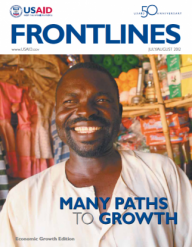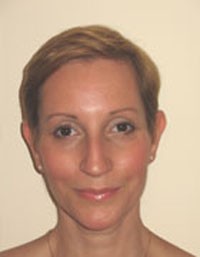The economist Robert Lucas once said: “Once you start thinking about [economic] growth, it’s hard to think about anything else.” Over the years, I have thought about that line more times than I can count. I have thought about it even more so lately as a small group of my fellow Agency economists and I have volunteered to spend some of our time thinking about just that issue. As economists, we all know what economic growth is—in its abstract form, it’s just a number—but it doesn’t feel like a number when I drive through the back roads and villages of Rwanda. There it has a very human face.
In many ways, figuring out how to unleash the growth potential of a given country remains the holy grail of economics. That’s not to say that it all remains a mystery. In fact, we know a great deal about growth and the conditions that foster and support it. But the quest goes on for better tools and better answers.
In 2005, economists Ricardo Hausmann, Dani Rodrik and Andres Velasco proposed a new methodology known as HRV [the initials of their last names] that would help countries identify key constraints to growth. That might not seem radical. In many countries, the constraints to growth seem all too clear. But are they the key constraints? When the cost of being wrong is so high, how can we know that we’re right? And how do we make those choices when they are so hard to make?
A couple of years ago, when I was working for a different development agency, I was asked to evaluate the economic potential of building a series of roads on a fairly sparsely populated island. Not surprisingly, the economic returns were nil. But the implementers still wanted to go forward. So one of the vice presidents of the agency called me into his office.
He listened closely as I laid out all of the reasons why funding the project was a terrible idea. And then he said: “I understand what you are saying, but don’t those people deserve a road?”
I knew that his concern was real. So I thought for a moment how best to respond and said: “Of course they deserve a road. Everyone deserves a road. Everyone deserves a decent home, food to eat, a good education. But what you are forgetting is that somewhere out there is another group of people with another project, a better project that could make a real difference in their lives. And just because you can’t see their faces and just because you don’t know their names doesn’t mean they aren’t there.”
As a child, some long forgotten teacher gave me a social studies book to keep for my own. I think it’s because I had read it so often and made the pages so dog-eared that she figured she might as well just give it to me. The pages were filled with the faces of children from exotic places that I knew I wanted to go to someday. But there was one page with one little girl that I kept going back to. She seemed around my age, with dark brown hair and eyes, sitting with her little brother on the steps of what was probably their home, but what was in fact little more than a few wood boards and tin sheets being held together by some miracle.
Even though I was also growing up poor in a housing project in the South Bronx, I knew that little girl’s life was so much harder than mine. And I wanted to understand why. Why was she there and I here? Why were there places so poor and people so poor that they couldn’t even have a decent roof over their heads? Did she go to school? Did she have toys to play with? Why wasn’t she sitting in my place with me staring back at her from the pages of that book?
That first set of questions, a child’s way of asking about growth, started a long journey of actually thinking about growth through college, graduate school, and finally, through 12 years working in development. But through all of it, the questions never changed and, for me, the nameless, faceless people we can’t see—the ones who can’t advocate for themselves because they are invisible to us —are all that little girl.
A Tool Worth Keeping
In many ways, HRV’s proposal is elegant and simple. It says, let’s take what we know about growth and the requirements for growth and apply them in a systematic way within a particular country-context to see what we can uncover. But the true beauty of the approach is that, although it’s a tool that’s about economic growth, it’s not a tool that is just about economics. It’s about everything that contributes to growth—health, education, governance—the things we do and the things we care about. When USAID applied this approach in El Salvador, as part of the Partnership for Growth process, safety and security emerged as one of the key constraints. Not access to finance. Not macro policy. But something as basic as the fact that economic activity cannot function effectively in an environment where crime and the uncertainty of what the future will bring persist.
A tool that can give us such important and unexpected answers to a core problem—helping countries to grow—is one worth keeping.
So back to that group of USAID economists sitting in a room thinking deep thoughts about growth. What we’ve been asking is: Can we make HRV an even better tool to address our development issues? Of course, we should feel heartened by the fact that a preponderance of empirical evidence shows that sustained growth is associated with a clear drop in poverty levels. Due in no small part to astounding global growth rates, between 1981 and 2008 the percentage of the world’s population living on less than $1.25 per day went from 52 percent to less than half of that—and HRV is targeted exactly on the issue of growth.
But it’s still a fair question to ask. Can we uncover the mechanics of how that process works at a more fundamental level and use that knowledge to better target our resources?
Currently, we are piloting some exciting alternative methodologies developed by USAID economists that are based on the original HRV, but that ask deeper questions about poverty and the poor. It will still be some months before we have solid results, but we are excited about the prospects of making a good tool even better.
A long time has passed since I was that little girl sitting with a ragged book on her lap. But even though I’m a big girl now and know so much more about the way the world works and how poverty can persist in a world with so much wealth, understanding why that little girl and I lived such worlds apart isn’t any easier.










Comment
Make a general inquiry or suggest an improvement.